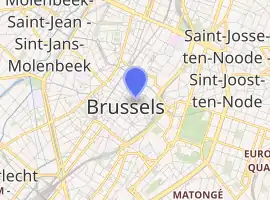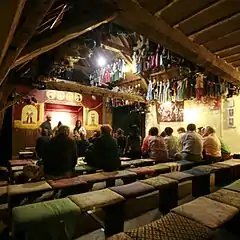Royal Theatre Toone
The Royal Theatre Toone (French: Théâtre royal de Toone, Dutch: Koninklijk Poppentheater Toone), is a folkloric theatre of marionettes in Brussels (Belgium), active since 1830, and the only traditional Brussels puppet theatre still in operation. To this day, it puts on puppet plays in Marols, the traditional Brabantian dialect of Brussels.[1] The building also houses a tavern and a small Brussels puppetry museum.[2]
.jpg.webp) Royal Theatre of Toone | |

| |
| Address | Rue du Marché aux Herbes / Grasmarkt 66 B-1000 City of Brussels, Brussels-Capital Region Belgium |
|---|---|
| Coordinates | 50°50′50″N 4°21′12″E |
| Type | Puppet theatre |
| Opened | 1830 |
| Website | |
| Official website | |
History
Around 1830, Antoine "Toone" Genty (1804–1890) opened his poechenellekelder (literally "puppet cellar"), a traditional puppet theatre in the Marolles/Marollen district of Brussels. This popular entertainment still exists and has grown today into the Royal Theatre Toone. The puppet theater was relocated to its current location near the Grand Place in central Brussels in 1966.[2]
Since the 1930s, Belgian personalities have taken part in the defense of this heritage, among them the avant-garde dramatist Michel de Ghelderode, who also wrote plays for the theatre. Later on, some of his other works were also adapted to theatre plays by the current owners, José Géal (also known as Toone VII), and his son Nicolas (also known as Toone VIII).
The building which houses the theatre and the alleyway where it is located have been designated as an ensemble since 27 February 1997.[3] A proposal is underway for the Royal Theatre Toone to obtain from UNESCO the status of masterpiece of intangible cultural heritage, a status already enjoyed by some eminent fellow puppeteers of popular tradition.[2]
Until 2018, the permanent museum of Toone was located on the first floor of the main building, and could be visited free of charge during performance hours. As part of extension works, three houses adjacent to the historic building were acquired and fully renovated thanks to a contribution of €1.3 million from Beliris. The main goal of these works, which lasted two years, is to improve accessibility and comfort for visitors, artists and suppliers, as well as to allow access to the museum outside performance hours.[4]
Ownership
Since its foundation in the Marolles in 1830, and during its eventful history, nine showmen have succeeded in the Toone dynasty. The transition does not necessarily take place from father to son. After Genty, the name Toone (Brussels' diminutive of Antoine) was adopted by these (unrelated) successive owners. In 2003, the eighth "generation" took office.[5]
.jpg.webp)
Historical owners
- Toone I, known as Toone the Elder (French: Toone l'Ancien): Antoine Genty (1804–1890), marollien, car painter by day and puppeteer by night. He could neither read nor write and made his own puppets. He cared little for historical truth and recounted popular legends, medieval epics and religiously inspired plays to a loyal audience, during a 45-year career.
- Toone II, known as Jan van de Marmit: François Taelemans (1848–1895), marollien, painter and friend of Toone I. He apprenticed as a puppeteer alongside Toone the Elder and succeeded him whilst keeping up the tradition. He had to change "puppet cellars" several times for hygiene and safety reasons.
- Toone III: after Toone II’s death, a turbulent period followed. Toone’s reputation was envied and around fifteen competing theatres attempted to appropriate the name. Two serious contenders claimed the title:
- Toone III, known as Toone de Locrel: Georges Hembauf (1866–1898), marollien, workman. Trained by Toone II, he gave his theatre a new dimension by adding to it a new repertoire, sets and puppets, which allowed him to keep his audience, despite the competition. His son was named Toone IV, the first hereditary succession.
- Toone III, known as Jan de Crol: Jean-Antoine Schoonenburg (1852–1926), marollien, hatter. Initiated with Toone the Elder, he resorted to a more evolved method of playwriting: he read novels, took notes, developed a canvas, and improvised the dialogues in front of his audience. His performances could sometimes last two months during which, every evening, the same regulars would come watch the show. Forced to give up the profession, which had become unprofitable, he ceded his theatre to Daniel Vanlandewijck, future Toone V, and hanged himself among his puppets.
- Toone IV: Jean-Baptiste Hembauf (1884–1966), marollien, son of Toone de Locrel. Associated with a puppet maker, Antoine Taelemans (son of Toone II), he directed his theatre for 30 years. However, with the break of World War I and the appearance of cinema, Toone IV was forced to close the doors of his theatre. The Amis de la marionnette ("Friends of the puppet"), a group of patrons, safeguarded the Brussels puppets and allowed Toone IV to resume his activities. He created Le mystère de la Passion, a play by Michel de Ghelderode written from oral tradition.
- Toone V: Daniel Vanlandewijck (1888–1938), factory worker. He bought Jan de Crol 's practice. Victim of an audience crisis and increasing hygiene requirements, he gave up the profession and sold his puppets. Bought by the Amis de la marionnette, the heritage was fortunately preserved.
- Toone VI: Pierre Welleman (1892–1974), workman. First associated with Toone V, he then succeeded him with his four sons. During World War II, a bomb fell next to his workshop and destroyed 75 puppets. Moreover, television and football represented new competitors. Struck with expropriation, Toone VI, discouraged, began to sell his puppets.
Current owners
- Toone VII: José Géal (1931–), comedian, he discovered the Theatre of Toone and founded his own company. When in 1963, exhausted by the difficulties encountered in safeguarding this Brussels' folklore, Toone VI stopped playing, José Géal officially replaced him as Toone VII. As he did not find an ideal place to set up his theatre in the Marolles, he moved to the current building, a stone's throw away from the Grand Place. In 1971, the City of Brussels bought this house to help Géal keep his puppets alive. Far from looking towards the past, Toone VII opened the Royal Theatre Toone to Europe and the world by updating the repertoire and translating his shows into English, but also Spanish, Italian and German (always interspersed with the Brussels dialect), thereby attracting a new audience. Tourists, students, the faithful and the curious are now replacing the marollien spectators. He was made Officer of the Order of Leopold in 2004.
- Toone VIII: Nicolas Géal (1980–), comedian, son of Toone VII, he was crowned Toone VIII on 10 December 2003. His first creation in 2006 was a Romeo and Juliet after William Shakespeare.
Practical information
Location and accessibility
The theatre is located north of the Grand Place, at the end of two narrow alleyways known as Impasse Schuddeveld/Schuddeveldgang and Impasse Sainte-Pétronille/Sint-Petronillagang (themselves located at, 66, rue du Marché aux Herbes/Grasmarkt). The district, commonly called Îlot Sacré since the 1960s, due to its resistance to demolition projects, is located within the perimeter of the Grand Place and consists of very dense city blocks testifying to the urban organisation of Brussels during the Middle Ages. The old buildings, meanwhile, belong to the so-called "reconstruction" period which followed the bombardment of the city in 1695.[2]
Opening hours
The theatre is open all year round, except in January. At least four shows are organised per week, every Thursday, Friday and Saturday at 8:30 p.m., and on Saturdays also at 4:00 p.m. Shows can be played in short version (+/- 45 minutes) or in full version (+/- 2 hours). The folkloric tavern on the ground floor is open every day from 12:00 to 24:00, except Monday (closing day).[2]
Gallery
 Entrance of the theatre
Entrance of the theatre Theatre room
Theatre room.jpg.webp) Puppet show
Puppet show Tavern
Tavern.jpg.webp) Old Puppets in the museum
Old Puppets in the museum Puppet collection
Puppet collection
See also
References
- Mary Anne Evans, Frommer's Brussels and Bruges Day by Day. First Edition (Hoboken: John Wiley & Sons, 2008), 71.
- "Théâtre Royal de Toone". www.toone.be. Retrieved 13 August 2019.
- "Bruxelles Pentagone - Théâtre Toone - Impasse Schuddeveld 6 - ROMBAUX Jean". www.irismonument.be. Retrieved 2020-11-21.
- "Inauguration de la nouvelle extension du Théâtre de Toone". BX1 (in French). 2018-11-14. Retrieved 2020-11-21.
- "Toone". World Encyclopedia of Puppetry Arts. 2016-04-28. Retrieved 2020-11-21.